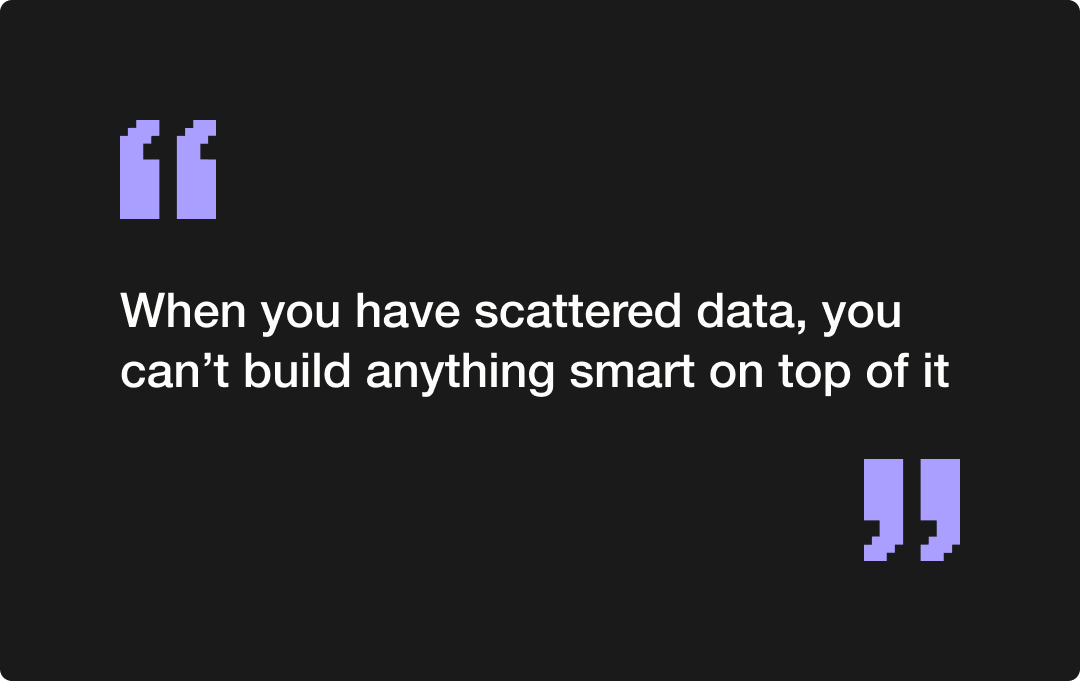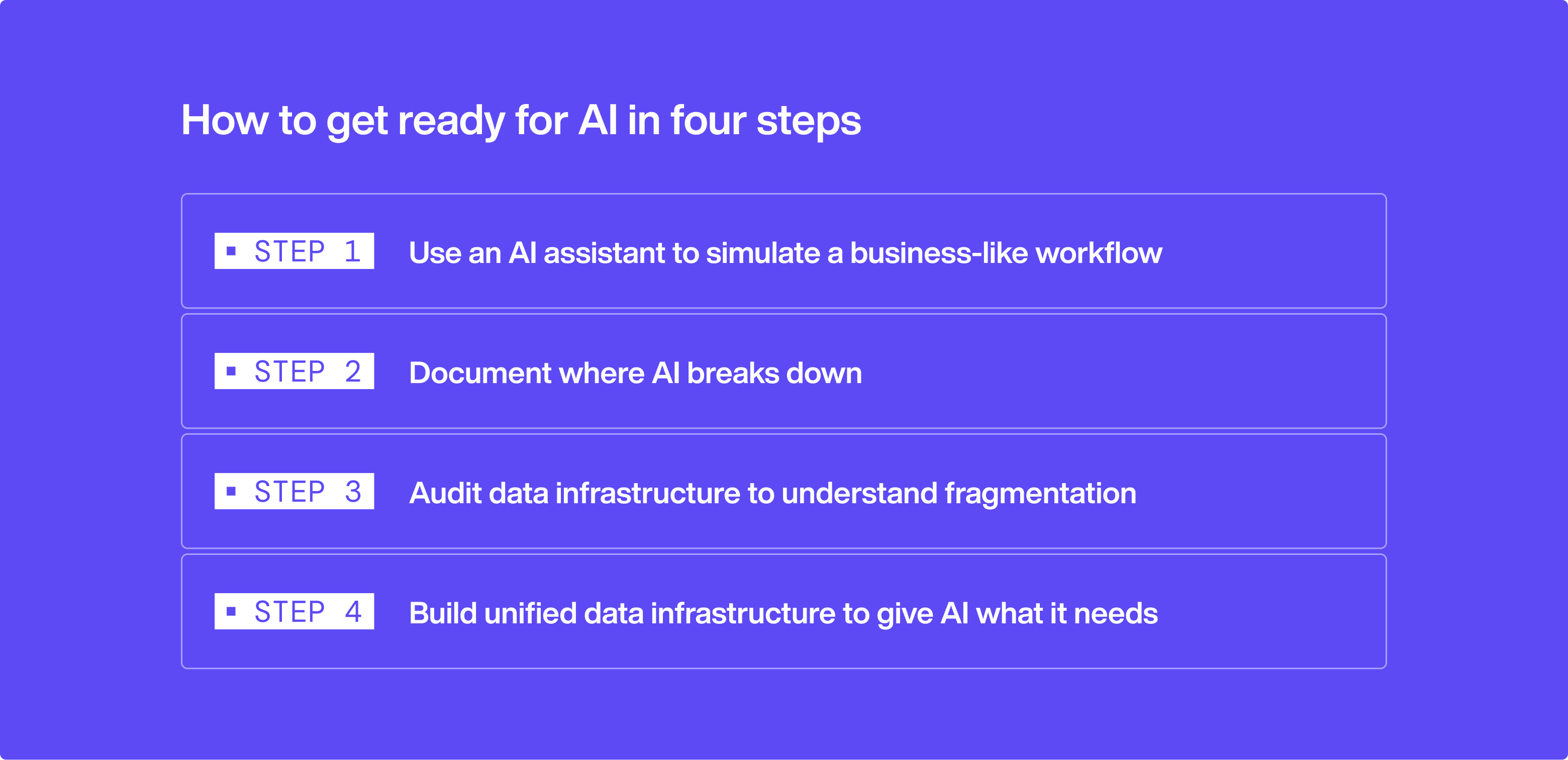How to Prepare Your Data Foundation for AI
AI is everywhere, and mid-market companies must seize the opportunity. Otherwise, they’ll get left behind.
But the reality, according to Limestone founder and chairman Mark Ajzenstadt, is that only about 10%–20% of companies are truly AI-ready. Research from Precisely and Drexel University shows that only 12% of organizations report that their data is of sufficient quality and accessibility for AI.
For most, the biggest obstacle to AI implementation isn’t their technology — it’s their foundation. AI is only as good as the data it’s built on, and organizations that lack a unified data infrastructure won’t reap the competitive benefits of AI.
Over his years guiding organizations through digital transformation challenges, Mark has developed an effective method for laying a stronger foundation. It all starts with feeding a single prompt to an AI assistant.
Key takeaways:
- Organizations are rushing toward AI with fragmented data foundations, setting themselves up to miss out on the competitive benefits it provides.
- Business leaders should simulate business-like workflows using an AI assistant to better understand the breakdown.
- Armed with this knowledge, organizations can more effectively audit their data infrastructure and prepare for AI implementation.


15-20% of revenue
Cost of data quality issues
7 - 12
Disconnected systems
3-6 month
Delays just to get basic
reporting
Building your dream home on a flawed foundation
Mid-market companies are experiencing intense AI FOMO. Under pressure to adapt or die, Mark observes that companies across industries are moving to implement AI quickly.
However, business leaders often confuse the capabilities of personal AI assistants, like ChatGPT, with what’s possible for their broader organization.
AI assistants perform well when given isolated tasks, like summarizing a single document or article. This performance creates an illusion of scalability, obscuring how difficult it is to apply AI to more complex business processes, like inventory and supply chain management.
As a result, many organizations rush toward AI implementation without understanding that they need to adjust their data infrastructure first. But without a connected data foundation, AI simply won’t have the queryable, contextual data it needs to function properly at the organizational level.
This is complicated by the fact that, for many organizations, data is highly fragmented. “When you have scattered data, you can’t really access everything you’ve collected,” Mark explains. “You can’t build anything smart on top of it.”
Building on unstable ground is like trying to run the latest software on a computer from 1995. No matter how good the new product is, with outdated infrastructure, the whole thing crashes.


Getting your data foundation right is personal
To address the gaps in their data foundation and prepare to deploy AI, organizations first need a concrete understanding of what those gaps are and why they are a problem.
Mark advises business leaders to start with personal AI experimentation, using an AI assistant to help conduct a business-like workflow: “For somebody that wants to use AI in the business and thinks that it’s doable with no foundation, I’d suggest that they try to use AI to assist with something that would require a deterministic state.”
In other words, experiment with AI assistance on tasks that require remembering and building on previous work. (More examples of this in the section below.)
This allows leaders to personally encounter the same data connectivity challenges that will inhibit organizational AI deployment. They’ll get firsthand insight into the issues that arise when AI encounters their fragmented data environments, while avoiding real-world consequences.


How to get ready for AI in four steps
1. Use an AI assistant to simulate a business-like workflow
Organizations should begin by having leaders experiment with AI tools to see how they maintain and update information across multiple interactions. This will test how AI handles critical business processes, where current tasks don’t occur in isolation but rather depend on accessing and building upon previous information.
For example, Mark recommends a transcript management exercise:
- Upload five meeting transcripts to ChatGPT and request summaries in a specific tone, format, and length.
- Instruct AI to output the summaries in a table with defined columns: Date, Topic, Summary, Tone.
- Ask AI to generate a changelog that will track all modifications to this table.
- Later, upload five additional transcripts, asking ChatGPT to update the existing table and changelog.


2. Document where AI breaks down
Organizations should record every breakdown during the transcript exercise, paying close attention to where AI becomes unreliable.
Mark notes that organizations will discover that an LLM cannot reliably maintain information between conversations without additional tooling in place.
For example, without constant reminders, the AI might switch between different table layouts each time it’s asked to update the table. It might add a new column, like meeting location, or switch the format of dates from “3/22/2025” to “March 22, 2025.” The user might also find that the AI hallucinated, reporting changes that sound plausible but never happened.
Effectively, each new turn or session is like working with a new assistant who has never seen your work before.


3. Audit data infrastructure to understand fragmentation
Once they have a preview of the reliability issues that may emerge with AI, organizations should audit their own data infrastructure to see how fragmented it has become.
Mark and the team at Limestone have discovered that the average mid-market company is working with anywhere between 7 and 12 disconnected systems.
Implementing AI on top of a disconnected foundation will only amplify reliability problems at enterprise scale. Incorrect, inconsistent results will not only inhibit effective decision-making for organizational users but also undermine their trust in AI.
4. Build unified data infrastructure to give AI what it needs
Following the audit of their data architecture, organizations should focus on the core infrastructure changes required for implementation.
At the heart of this transformation, Mark shares that organizations must establish data pipelines that automatically consolidate data into a centralized repository, such as a data lake. He also emphasizes the importance of implementing vector database capabilities. These core components work together to create unified, consistent, and accessible data, helping to provide AI with the business context required to function reliably.
While traditional data transformation initiatives can stretch across months of complex planning and execution, Mark highlights that a focused approach can help tackle these foundational challenges in a fraction of the time. For example, Limestone works with clients to tackle these tasks in 4–6 week sprints to accelerate the path to AI readiness. Unlike traditional consultants who take 3-4 months just for assessment, Limestone delivers working infrastructure in the time it takes others to write a proposal.
Victory in the AI arena
The pressure to implement AI is high — but organizations should not let the urgency rush them into improper implementation. A job done quickly but wrong is still a job done wrong.
If organizations can create a connected data foundation, their AI tools will be more reliable across the business, fed by unified and consistent data.
But leave fragmentation unchecked, and deploying AI across enterprise systems will inevitably fail, wasting significant time and investment dollars. Meanwhile, more foundationally sound competitors will enjoy immediate operational improvements and surge ahead.
In the AI era, the future belongs to those who build on solid foundations. Start building yours today.


Let's start with a diagnostic.
- Custom mapping of risks, integration points, and tech gaps
- Actionable follow-up playbook if there's a fit










